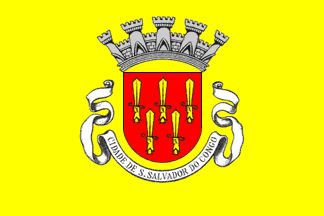
Last modified: 2022-10-22 by bruce berry
Keywords: angola |
Links: FOTW homepage |
search |
disclaimer and copyright |
write us |
mirrors
 Image
by
António Martins-Tuválkin,
27 May 2016
See also:
Image
by
António Martins-Tuválkin,
27 May 2016
See also:
Several municipalities of the Overseas Portuguese Empire which had adopted Coats of Arms were subjected in the late 1930s and 1940s to the same kind of homogenization that their metropolitan counterparts in Portugal had been the subjected to during the previous decade at the hands of the SHAAP/CHAAP (q.v.), this time with the help of the Overseas/Colonies’ Ministry. The start of the Colonial Wars in 1961 led to the creation of several more, as granting symbols to settlements (and other similar accolades such as the upgrading of their municipal upgrading) was one way for the Portuguese Government to thank or compensate local populations and/or elites for war damages.
Ministerial Decree no.19076 of 15 March 1962, issued by the Overseas
Ministry, enacted the first of these adoptions. The preamble to the Decree
explicitly grants the "privilege of using their own coat of arms and flag" to
the
"main settlements of the areas that suffered most" during the 1961
anti-colonialist attacks. (This happens 30 years after it was found a natural
thing that each and every municipality of mainland Portugal, Azores and Madeira,
i.e., the white-inhabited areas of the empire, should adopt such symbols).
The Decree was published in the official journal
Diário do Govêrno : I
série *58* of 13 March 1962 (pp.237-238).
M'banza Kôngo is the historic capital of the Kingdom of the Kongo and is capital of Angola's northwestern Zaire province. The town was founded some time before the arrival of the Portuguese in 1483 and was the capital of the Kilukeni dynasty ruling in the area at that time. The site was temporarily abandoned during the civil wars in the 17th century. It lies close to Angola's borer with the Democratic Republic of Congo and sits atop a massive flat-topped mountain, sometimes called Mongo a Kaila (mountain of division) because recent legends recall that the king created the clans of the kingdom and sent them out from there. In the valley to the south runs the Luezi River.
António Martins-Tuválkin, 27 May 2016One of the 18 Angolan settlements covered by this first decree is São Salvador do Congo, more commonly called Banza-Congo or M'banza Kôngo in current Portuguese orthography (in Kikongo: Mbanza Kôngo). Its Coat of Arms and flag are described as "_1.º_ _De vermelho, carregado de cinco punhais de ouro, postos III e II, lavrados, guarnecidos e empunhados do mesmo._" " _2.º_ Amarela. Cordões e borlas de ouro._"
It is a typical Portuguese municipal flag with the Arms centered on a plain
yellow background. The arms are Gules five daggers Or garnished and hilted of
the Same and set three and two. Mural crown Argent with five visible towers and
white scroll with "CIDADE DE SÃO SALVADOR DO CONGO" in black capitals. The
banner should have golden tassels and cord (The legal specifications for the
crown and scroll are given
wholesale in §1 and §2 of art. 1.º, not individually as it is customary.
The five daggers are from the
Arms of the Kingdom of Kongo as during the mid-15th century .
The Arms, along with many other Angolan municipal arms, was published on a
postage stamp
of the Portuguese Angola Post, with a face value of 3$50. It can also been seen
here.
António Martins-Tuválkin,
27 May 2016
Another
image of the Arms, in monochrome line draw style can be seen
here.
António Martins-Tuválkin,
02 May 2017